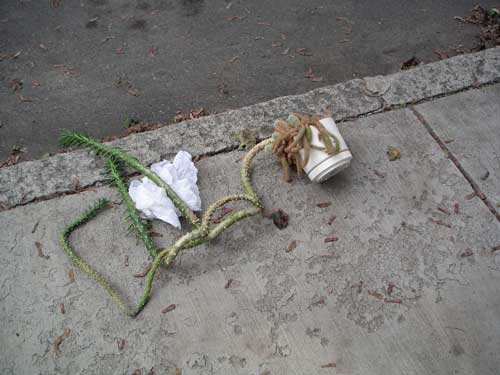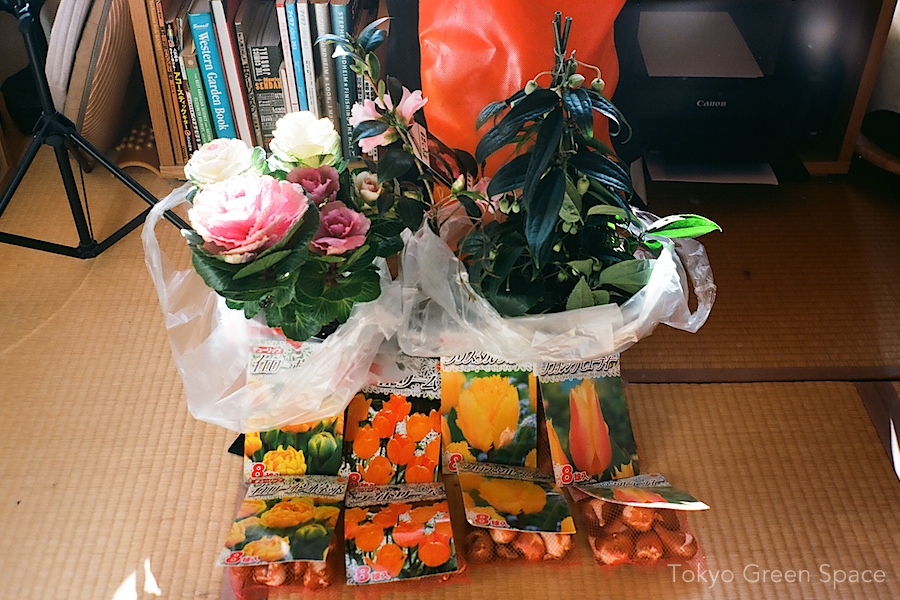
自転車で持ち帰った冬の植物です。チューリップの球根やキャベツやクレマチス。
Tulip bulbs, decorative cabbage, and a winter clematis.

最近、不動産関係のコンサルティングをさせていただいているので、都市開発の魅力について考えています。東京の高級住宅はよくカタカナ英語を使います。けれども、日本のお客さまへのものなので、和製英語が多いですね。
Recently I am consulting for one of Japan’s largest real estate companies seeking to attract residents to a waterfront area that many might not have considered before. What makes an apartment or a neighborhood desirable? What architectural and landscape choices are most important? What are the trends today and in the future that drive consumer choice?
As an English speaker in Tokyo, I am also always drawn to the selective English language marketing, often an odd English name for the property. This building advertised in the Sendagaya JR station has a name that has a certain logic, but which also completely fails as an English language name.
Yes, Gro-bel is a shortened form of “Grow Best Life Stage.” It’s also the Japanese pronunciation of the word “global.” What was meant as optimistic, modern and international, instead comes off as bizarre, stilted, and heavy handed. In this context, using English is more decorative than functional or expressive.

旅行中、東京のお母さんがベランダの庭を世話てくれるので、私はラッキーです。今回、かわいいチョコてんとう虫が迎えてくれました。久家先生、ありがとうございます!
I am lucky that when we go on a short trip, my mother-in-law comes over to water the balcony garden by hand. This time, these cute chocolate ladybugs welcomed me home. Thanks, Kuge sensei.

This small succulent pair has grown well all winter long on my balcony. I brought it inside for a few days on our window seat. This is one of the first ceramics I made at my in-laws’ crafts studio, Kuge Crafts. I’m working with them now to create a new website for their studio.

The laundry line in our Tokyo flat is ever present, in the middle of the garden and directly in view from the kitchen table desk. Whether decorative or not, the laundry line is a porous border between inside and out, home and neighbors.
My handkerchief collection now includes the Bulgarian Kotooshu, one of the longest serving ozeki sumo wrestlers, as well as Asashoryu, the Mongolian yokozuna forced out of the profession a few years ago for bad behavior. Given the function of handkerchiefs, perhaps it’s not the most appropriate form of hero worship.

この停留所は東京グリーンスペースの比喩です。昔、公共スペースは計画されたことがありません。今は都市の指導者と官僚が車中心社会とメガ開発を支えすぎます。3.11の前、政府が悪くても、東京はいい都市だと思いました。3.11の後、無能な指導者は危ないと思います。
年末が近づくにしたがって、もっと生きている都市をどう作れるかと考えています。
This sidewalk and street have nearly no visible plants. Yet anonymously gifted bus stop chairs are very Tokyo and very much in the spirit of Tokyo green space. Reacting to a lack of infrastructure– no shelter and no seating– neighbors simply recycle and re-use stuff from their homes and share it with neighbors in a public space.
Few designers could have coordinated this unlikely mix of colors, fabrics, and shapes. Its aesthetic arises from its spontaneous appearances. Is this the most beautiful, practical, or ideal solution to the lack of infrastructure? Probably not, although it reflects generosity and concern for others in shared spaces.
I have been writing about Tokyo green space for a while, ever since moving here three years ago. Tokyo is surprisingly green and livable despite the complete absence of planning for public open space, from its rise as Japan’s Edo capitol in the 1600s through the 20th century’s natural and man-made calamities that twice obliterated the city.
Tokyo has such forward-looking urban features like walkable small streets dominated by pedestrians and bicyclists. But these vital paths exist not because of contemporary Tokyo’s good planning, but because the bureaucracy still in the thrall of automobile infrastructure and mega-developments hasn’t had the chance to alter them.
Documenting Tokyo green space has been a way for me to understand the life of this city. The grass-roots reclaiming of public space certainly increases the city’s appeal. But, post 3.11, I also now wonder if the residents haven’t demanded enough of the city leaders. We now know more clearly the dangers of leaving vital decisions to reckless and outdated politicians and bureaucrats.
As this difficult year ends, I wonder what all of us can do to create a more alive city.

冬のために、小さな庭の準備ができました。木を短く剪定したので、日光が家に入ってこれます。何百も植木鉢があるから、駐車場を使わないそうです。
I like how this small home is prepared for winter: the tree’s been hard pruned, the bushes rounded and shaped, and nothing out of place. The pruning looks severe, but it serves to bring more sunlight into the house for winter. I like the mix of western plants and Japanese traditional garden elements. And the hundreds of small pots lining the driveway. I have a feeling that they never park a car there.

まだ冬なのに、東京のどこにもジンチョウゲがすてきな匂いをさせています。
Everywhere I walk in Tokyo, I notice the incredible scent of Winter Daphne (daphne odora, or ジンチョウゲ). Beginning in late February, between plum and cherry blossom seasons, this compact bush with glossy leaves produces hundreds and thousands of red flower buds that open pink and release a mesmerizing scent. It must be easy to grow since I’ve seen it planted in front of offices and houses. The photo above is from the new Nakano Marui department store, which has created a very lovely garden and mid-block pathway that I will write about soon.
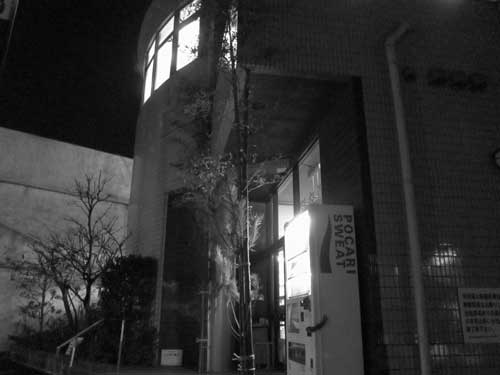
東京のお正月の時だけですが、神様を迎え入れます.
Tokyo residents and small businesses welcome the gods in temporary homes built of bamboo, pine, and plum blossoms.
I love how the best ones are hand-crafted from pine, bamboo, and plum blossoms. They are intended to be temporary homes for the Shinto gods (kami, 神様). I like the idea that you can create a temporary house for the gods to visit at new year. The three heights of the kamomastu represent heaven, humanity, and earth- in descending order. The shimekazari are smaller, with Shinto rope holding charms such as oranges, folded paper, rice straw, and ferns.
Shimekazari (標飾り) and Kadomatsu (門松) are traditional New Year’s ornaments placed on walls and on the sidewalks outside shops and homes. The city simultaneously empties of people and fills with physical connections to mountains and spirits. This year I took photos of the widest variety I could find in the areas I visit on typical days: on a car bumper, outside a sento, next to a wall of cigarette advertisements, on a busy boulevard, outside a barbershop, pachinko parlor, 24 hour convenience store, and a department store.
After the holiday, these decorations should be burned at a shrine. By mid-January, they are already a faded memory.
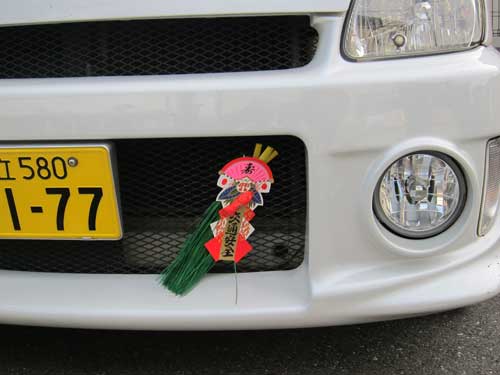
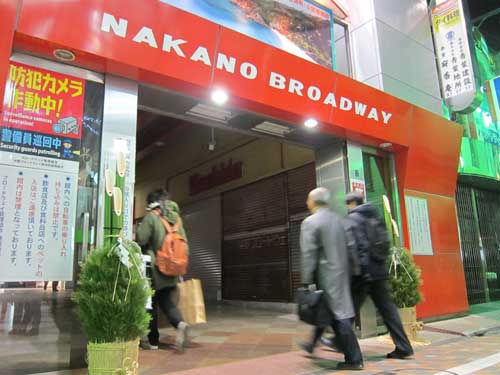

See more photos after the jump.
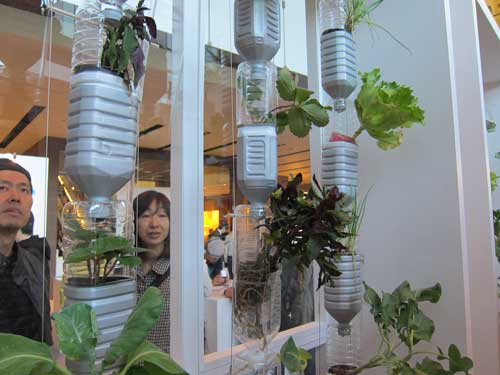
At Tokyo’s Design Touch, I came across Britta Riley’s WindowFarm. It’s a vertical hydroponic system for growing vegetables in apartment windows. I like the idea that city people can grow their own food, that vertical urban space can be better used, and the premise of R&D-I-Y (do it yourself R&D), where customers use web “crowdsourcing” to contribute new ideas about the product.
WindowFarm has appeared at New York’s Museum of Modern Art, the Venice Biennial, and even Martha Stewart’s TV show. The installation I saw really showed off how space-efficient the system is. The parts I am less keen on include the hydroponic system and the pump. The idea of using chemicals and electricity, to me, seems contrary to simplicity and nature. However, I know that many people are strong believers in hydroponic farming.
What do you think? Would you install this system in your home? Could it be done with soil instead of hydroponics? What do you think of creating an online community to support micro-urban farming?
WindowFarm also reminds me of one of the first images from Tokyo Green Space: the “pet bottle” (Japan’s name for disposable beverage containers) supporting a plant in Metro station men’s room. That installation was entirely no-tech, and yet both rely on this ubiquitous and wasteful bottle that we can’t seem to live without.


Tokyo’s mild winter is amazing. All these photos of winter flowers are from yesterday, January 20, 2010. Ranging from natural to forced, outdoors to indoors, the flowers include early plum blossom along an urban path to a red tulip in a sidewalk garden, to a mini daffodil at home.
 Starting a week ago, this plum tree along a walking path to Nakano JR station began opening its petals. The tree extends from a private garden into a public path. After November and December’s camellias (and my balcony pink camellia is still blooming), the winter plums suggest that there is no month in Tokyo without flowers blooming naturally. My husband saw bright green mejiro birds in the tree later that day.
Starting a week ago, this plum tree along a walking path to Nakano JR station began opening its petals. The tree extends from a private garden into a public path. After November and December’s camellias (and my balcony pink camellia is still blooming), the winter plums suggest that there is no month in Tokyo without flowers blooming naturally. My husband saw bright green mejiro birds in the tree later that day.

 I also noticed these bright red tulips in a Nakano sidewalk garden that I often pass. It’s the garden that was growing rice in styrofoam containers last year. The gardener has planted some bulbs, but she’s also added some hothouse-forced bulbs to her charming public garden. Because frost is so rare, the tulips can thrive even in mid-winter.
I also noticed these bright red tulips in a Nakano sidewalk garden that I often pass. It’s the garden that was growing rice in styrofoam containers last year. The gardener has planted some bulbs, but she’s also added some hothouse-forced bulbs to her charming public garden. Because frost is so rare, the tulips can thrive even in mid-winter.
I also saw another neighbor cutting roses from her sidewalk garden. Pansies are also common in winter.
Lastly, inspired by all this winter color, I bought some mini-daffodils for my home. Indoors, they go from bud to bloom incredibly fast. The bright yellow cheers up the apartment and fools me into thinking that spring is not so far away.

Wayward plants
A London art, plants and urbanist organization Waywardplants.org rescues unwanted plants– “discarded, abandoned, rogue, stray or runaway”— and discovers new homes where they will be cared for. This horticultural intervention has created adoption forms, placed itself in the Barbican Art Gallery in London, and encompasses a full life range from “freecycle” sharing to composting “cemetaries.”
You can watch a Wayward Plant presentation made at Pecha Kucha London. As all their talks, it is 20 slides at 20 seconds, for a total less than 7 minutes. They will also be participating in the Graham Foundation‘s exhibit, “ACTIONS: What you can do with the city” that presents 99 actions “that instigate positive change in contemporary cities around the world” based on common activities such as walking, playing, recycling, and gardening. It’s in Chicago until March 13, 2010.
